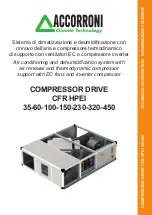
GB
11
Intended Use
• Mains-powered, oil-lubricated, 2.0hp air compressor with large capacity, 50 litre,
compressed air tank. Supplies power to a wide variety of air tools, including spray guns
and impact wrenches
Unpacking Your Tool
WARNING: This device is very heavy and should NOT be unpacked and handled by a single
person.
• Carefully unpack and inspect your tool. Fully familiarise yourself with all its features and
functions
• Ensure that all parts of the tool are present and in good condition. If any parts are missing
or damaged, have such parts replaced before attempting to use this tool
Before Use
Transport wheel installation
1. Place the air compressor unit on a secure flat surface ready for assembly, and locate the
Transport Wheels (14) and fixings
2. Carefully place the air compressor unit on its side to gain access to the wheel mounting
hole
3. Slide the Axle (16) through the centre of the Transport Wheel, followed by the wheel
mounting hole
4. Fasten using corresponding nut and crush washer
5. Repeat steps 1-4 for the other side
Rubber foot installation
1. Place the air compressor unit on a secure, flat surface to reveal the foot mounting hole
(Image I). Locate the Rubber Foot (12) and fixings
2. Slide the supplied fixing bolt through the bottom of the Rubber Foot (Image II), then
through the foot mounting hole, and fasten using the corresponding nut
3. Access to the other foot mounting hole is available from the air compressor’s current
position. Repeat steps 1-2
Air filter installation
1. The threaded air intake port is located on the side of the Cylinder Head (Image III)
2. Screw the Air Filter (15) into the air intake port
Filling with motor oil
WARNING: This air compressor is supplied without oil. DO NOT attempt to start the motor
before you have filled the motor with the appropriate type and amount of oil.
WARNING: Only use an oil type listed in the ‘Specification’. High viscosity oil could create
blockages due to improper circulation during cold starts. A low viscosity oil will be unable to
lubricate the compressor sufficiently.
Note: Always place the air compressor on a level surface before filling motor oil or checking
oil levels.
1. Position the air compressor on a secure, flat surface
2. Remove the shipping plug from the crankcase breather hole, and store in a safe place.
The crankcase breather hole is now accessible
Note: This compressor features an external Oil Level Monitor (5) (Image IV), for easy
monitoring of oil levels.
3. Fill with suitable motor oil to the centre of the red ‘full’ mark on the Oil Level Monitor, see
‘Specification’ for details regarding suitable motor oil
4. Screw the Crankcase Breather (3) into the crankcase breather hole
Fitting the quick connector
Note: This tool is supplied with two different female airline quick connectors:
EN-6 – mainly used in the UK (Fig. A)
EQ-4 – commonly used in Europe (Fig. B)
• Please choose the connector that is compatible with the airline system you are using, and
install as outlined below:
1. Apply PTFE tape (not included) to the screw threads of the Quick Connector (10). This
will help maintain an air-tight seal
Note: Apply PTFE tape tightly and in a clockwise direction, so it does not come off when the
thread is screwed into the tool.
2. Remove the protective plug from the air inlet
3. Using a spanner (not included), screw the Quick Connector into the air inlet located at the
base of the handle
4. Connect to airline, pressurise carefully and carry out a leak check (e.g. by spraying small
amounts of soapy water on to the outside of the connectors)
• Air lines fitted with matching male quick connectors will now be a push fit to the tool
Check valves and fasteners
Note: Always check the operation of the Pressure Release Valve (8) before use; its function
is imperative to the safe use of this air compressor.
• Ensure all valves and fasteners are correctly tightened/seated for operation before each
use
Operation
WARNING: Always use adequate protective equipment, including eye protection, respiratory
and hearing protection, when working with this tool.
Switching on and off
1. Check that the compressor is disconnected from all air tools or air lines and that the ON/
OFF Switch (6) is depressed
2. Connect the machine to the mains power supply
3. Pull the ON/OFF Switch (6) upwards. This will start the compressor
4. Allow the compressor to build pressure; the tank pressure is displayed on the Pressure
Gauge (7). When the Reservoir Tank (1) pressure reaches 8bar (116psi), the motor will
stop automatically
5. Press the ON/OFF Switch down to switch the compressor off
Connecting air tools
• Tools can be connected to the Quick Connector (10) using a suitable air line fitted with a
corresponding ¼" bayonet type male connector
• Always ensure that air tools are in the 'off' position before connecting. Tools will be
pressurised as soon as the connections are made
• To connect an air tool, fit the air line to the tool, then push the bayonet fitting into the
Quick Connector outlet of the compressor
• Once connected, the output pressure can be adjusted. Turn the Pressure Regulator
(11) clockwise to increase pressure, and anti-clockwise to decrease pressure. The line
pressure is displayed on the Pressure Gauge (7)
• Release the air line by pulling back the outer sheath of the high pressure outlet and
pulling the bayonet fitting out. Be aware that the air line and tool will hold residual air
pressure
270120_Z1MANPRO1.indd 11
22/07/2014 17:03












































